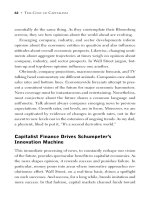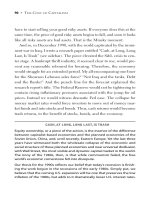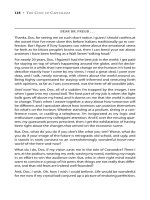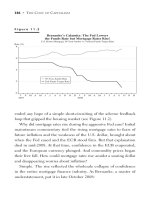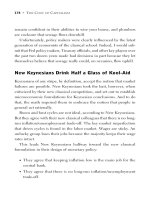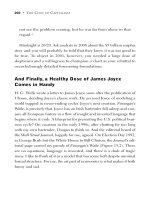Financial managment Solution Manual: The Cost of Capital
Bạn đang xem bản rút gọn của tài liệu. Xem và tải ngay bản đầy đủ của tài liệu tại đây (156.92 KB, 21 trang )
After reading this chapter, students should be able to:
• Explain what is meant by a firm’s weighted average cost of capital.
• Define and calculate the component costs of debt and preferred stock.
• Explain why retained earnings are not free and use three approaches to
estimate the component cost of retained earnings.
• Briefly explain why the cost of new common equity is higher than the
cost of retained earnings, calculate the cost of new common equity, and
calculate the retained earnings breakpoint which is the point where new
common equity would have to be issued.
• Briefly explain the two alternative approaches that can be used to
account for flotation costs.
• Calculate the firm’s composite, or weighted average, cost of capital.
• Identify some of the factors that affect the overall, composite cost of
capital.
• Briefly explain how firms should evaluate projects with different risks,
and the problems encountered when divisions within the same firm all use
the firm’s composite WACC when considering capital budgeting projects.
• List and briefly explain the three separate and distinct types of risk
that can be identified, and explain the procedure many firms use when
developing subjective risk-adjusted costs of capital.
• List some problem areas in estimating the cost of capital.
Learning Objectives: 9 - 1
Chapter 9
The Cost of Capital
LEARNING OBJECTIVES
Chapter 9 uses the rate of return concepts covered in previous chapters, along
with the concept of the weighted average cost of capital (WACC), to develop a
corporate cost of capital for use in capital budgeting.
We begin by describing the logic of the WACC, and why it should be used
in capital budgeting. We next explain how to estimate the cost of each
component of capital, and how to put the components together to determine the
WACC. We go on to discuss factors that affect the WACC, how to adjust the
cost of capital for risk, and estimating project risk. We conclude the
chapter with a discussion on some problem areas in the cost of capital.
The details of what we cover, and the way we cover it, can be seen by
scanning Blueprints, Chapter 9. For other suggestions about the lecture,
please see the “Lecture Suggestions” in Chapter 2, where we describe how we
conduct our classes.
DAYS ON CHAPTER: 3 OF 58 DAYS (50-minute periods)
Lecture Suggestions: 9 - 2
LECTURE SUGGESTIONS
9-1 Probable Effect on
k
d
(1 - T) k
s
WACC
a. The corporate tax rate is lowered. + 0 +
b. The Federal Reserve tightens credit. + + +
c. The firm uses more debt; that is, it
increases its debt/assets ratio. + + 0
d. The dividend payout ratio is
increased. 0 0 0
e. The firm doubles the amount of capital
it raises during the year. 0 or + 0 or + 0 or +
f. The firm expands into a risky
new area. + + +
g. The firm merges with another firm
whose earnings are counter-cyclical
both to those of the first firm and
to the stock market. - - -
h. The stock market falls drastically,
and the firm’s stock falls along with
the rest. 0 + +
i. Investors become more risk averse. + + +
j. The firm is an electric utility with a
large investment in nuclear plants.
Several states propose a ban on
nuclear power generation. + + +
9-2 Beta (market) risk refers to the project’s effect on the corporate beta
coefficient. Within-firm (corporate) risk refers to the project’s
effect on the stability of the firm’s earnings. Stand-alone risk refers
Answers and Solutions: 9 - 3
ANSWERS TO END-OF-CHAPTER QUESTIONS
to the inherent riskiness of the project’s expected returns when viewed
alone. Theoretically, beta (market) risk is the most relevant measure
because of its effect on stock prices.
9-3 The cost of capital for average-risk projects would be the firm’s cost
of capital, 10 percent. A somewhat higher cost would be used for more
risky projects, and a lower cost would be used for less risky ones. For
example, we might use 12 percent for more risky projects and 9 percent
for less risky projects. These choices are arbitrary.
9-4 Each firm has an optimal capital structure, defined as that mix of
debt, preferred, and common equity that causes its stock price to be
maximized. A value-maximizing firm will determine its optimal capital
structure, use it as a target, and then raise new capital in a manner
designed to keep the actual capital structure on target over time. The
target proportions of debt, preferred stock, and common equity, along
with the costs of those components, are used to calculate the firm’s
weighted average cost of capital, WACC.
The weights could be based either on the accounting values shown on
the firm’s balance sheet (book values) or on the market values of the
different securities. Theoretically, the weights should be based on
market values, but if a firm’s book value weights are reasonably close
to its market value weights, book value weights can be used as a proxy
for market value weights. Consequently, target market value weights
should be used in the WACC equation.
9-5 An increase in the risk-free rate will increase the cost of debt.
Remember from Chapter 4, k = k
RF
+ DRP + LP + MRP. Thus, if k
RF
increases so does k (the cost of debt). Similarly, if the risk-free
rate increases so does the cost of equity. From the CAPM equation, k
s
=
k
RF
+ (k
M
– k
RF
)b. Consequently, if k
RF
increases k
s
will increase too.
9-6 In general, failing to adjust for differences in risk would lead the
firm to accept too many risky projects and reject too many safe ones.
Over time, the firm would become more risky, its WACC would increase,
and its shareholder value would suffer.
Answers and Solutions: 9 - 4
9-1 40% Debt; 60% Equity; k
d
= 9%; T = 40%; WACC = 9.96%; k
s
= ?
WACC = (w
d
)(k
d
)(1 - T) + (w
c
)(k
s
)
0.0996 = (0.4)(0.09)(1 - 0.4) + (0.6)k
s
0.0996 = 0.0216 + 0.6k
s
0.078 = 0.6k
s
k
s
= 13%.
9-2 P
p
= $47.50; D
p
= $3.80; k
p
= ?
k
p
=
P
D
p
p
k
p
=
$47.50
$3.80
= 8%.
9-3 P
0
= $30; D
1
= $3.00; g = 5%; F = 10%; k
s
= ?; k
e
= ?
k
s
=
0
1
P
D
+ g =
$30.00
$3.00
+ 0.05 = 15%.
k
e
=
)F1(P
D
0
1
−
+ g =
0.10) - $30(1
$3.00
+ 0.05
=
$27.00
$3.00
+ 0.05 = 16.11%.
9-4 Projects A, B, C, D, and E would be accepted since each project’s return
is greater than the firm’s WACC.
9-5 k
d
(1 - T) = 0.12(0.65) = 7.80%.
9-6 k
p
=
$92.15
$100(0.11)
=
$92.15
$11
= 11.94%.
Answers and Solutions: 9 - 5
SOLUTIONS TO END-OF-CHAPTER PROBLEMS
9-7 a. k
s
=
0
1
P
D
+ g
k
s
=
0.06 +
$36
$3.18
k
s
= 14.83%.
b. F = ($36.00 - $32.40)/$36.00 = $3.60/$36.00 = 10%.
c. k
e
= D
1
/[P
0
(1 - F)] + g = $3.18/$32.40 + 6% = 9.81% + 6% = 15.81%.
9-8 Capital Sources Amount Capital Structure Weight
Long-term debt $1,152 40.0%
Equity 1,728 60.0
$2,880 100.0%
WACC = w
d
k
d
(1 - T) + w
c
k
s
= 0.4(0.13)(0.6) + 0.6(0.16)
= 0.0312 + 0.0960 = 12.72%.
9-9 k
s
= D
1
/P
0
+ g = $2(1.07)/$24.75 + 7%
= 8.65% + 7% = 15.65%.
WACC = w
d
(k
d
)(1 - T) + w
c
(k
s
); w
c
= 1 - w
d
.
13.95% = w
d
(11%)(1 - 0.35) + (1 - w
d
)(15.65%)
0.1395 = 0.0715w
d
+ 0.1565 - 0.1565w
d
-0.017 = -0.085w
d
w
d
= 0.20 = 20%.
9-10 a. k
d
= 10%, k
d
(1 - T) = 10%(0.6) = 6%.
D/A = 45%; D
0
= $2; g = 4%; P
0
= $20; T = 40%.
Project A: Rate of return = 13%.
Project B: Rate of return = 10%.
k
s
= $2(1.04)/$20 + 4% = 14.40%.
b. WACC = 0.45(6%) + 0.55(14.40%) = 10.62%.
c. Since the firm’s WACC is 10.62% and each of the projects is equally
risky and as risky as the firm’s other assets, MEC should accept
Project A. Its rate of return is greater than the firm’s WACC.
Project B should not be accepted, since its rate of return is less
than MEC’s WACC.
9-11 Debt = 40%, Equity = 60%.
P
0
= $22.50, D
0
= $2.00, D
1
= $2.00(1.07) = $2.14, g = 7%.
Answers and Solutions: 9 - 6
k
s
=
0
1
P
D
+ g =
50.22$
14.2$
+ 7% = 16.51%.
WACC = (0.4)(0.12)(1 - 0.4) + (0.6)(0.1651)
= 0.0288 + 0.0991 = 12.79%.
9-12 If the firm's dividend yield is 5% and its stock price is $46.75,
the next expected annual dividend can be computed.
Dividend yield = D
1
/P
0
5% = D
1
/$46.75
D
1
= $2.3375.
Next, the firm's cost of new common stock can be determined from the DCF
approach for the cost of equity.
k
e
= D
1
/[P
0
(1 - F)] + g
k
e
= $2.3375/[$46.75(1 - 0.05)] + 0.12
k
e
= 17.26%.
9-13 a. Examining the DCF approach to the cost of retained earnings, the
expected growth rate can be determined from the cost of common
equity, price, and expected dividend. However, first, this problem
requires that the formula for WACC be used to determine the cost of
common equity.
WACC = w
d
(k
d
)(1 - T) + w
c
(k
s
)
13.0% = 0.4(10%)(1 - 0.4) + 0.6(k
s
)
10.6% = 0.6k
s
k
s
= 0.17667 or 17.67%.
From the cost of common equity, the expected growth rate can now be
determined.
k
s
= D
1
/P
0
+ g
0.17667 = $3/$35 + g
g = 0.090952 or 9.10%.
b. From the formula for the long-run growth rate:
g = (1 - Div. payout ratio) × ROE = (1 - Div. payout ratio) ×
(NI/Equity)
0.090952 = (1 - Div. payout ratio) × ($1,100 million/$6,000 million)
0.090952 = (1 – Div. payout ratio) × 0.1833333
0.496104 = (1 – Div. payout ratio)
Div. payout ratio = 0.503896 or 50.39%.
9-14 If the investment requires $5.9 million, that means that it requires
Answers and Solutions: 9 - 7
$3.54 million (60%) of equity capital and $2.36 million (40%) of debt
capital. In this scenario, the firm would exhaust its $2 million of
retained earnings and be forced to raise new stock at a cost of 15%.
Needing $2.36 million in debt capital, the firm could get by raising debt
at only 10%. Therefore, its weighted average cost of capital is: WACC =
0.4(10%)(1 - 0.4) + 0.6(15%) = 11.4%.
9-15 a. If all project decisions are independent, the firm should accept all
projects whose returns exceed their risk-adjusted costs of capital.
The appropriate costs of capital are summarized below:
Required Rate of Cost of
Project Investment Return Capital
A $4 million 14.0% 12%
B $5 million 11.5 12
C $3 million 9.5 8
D $2 million 9.0 10
E $6 million 12.5 12
F $5 million 12.5 10
G $6 million 7.0 8
H $3 million 11.5 8
Therefore, Ziege should accept projects A, C, E, F, and H.
b. With only $13 million to invest in its capital budget, Ziege must
choose the best combination of Projects A, C, E, F, and H.
Collectively, the projects would account for an investment of $21
million, so naturally not all these projects may be accepted.
Looking at the excess return created by the projects (rate of return
minus the cost of capital), we see that the excess returns for
Projects A, C, E, F, and H are 2%, 1.5%, 0.5%, 2.5%, and 3.5%. The
firm should accept the projects which provide the greatest excess
returns. By that rationale, the first project to be eliminated from
consideration is Project E. This brings the total investment
required down to $15 million, therefore one more project must be
eliminated. The next lowest excess return is Project C. Therefore,
Ziege's optimal capital budget consists of Projects A, F, and H, and
it amounts to $12 million.
c. Since Projects A, F, and H are already accepted projects, we must
adjust the costs of capital for the other two value producing
projects (C and E).
Required Rate of Cost of
Project Investment Return Capital
C $3 million 9.5% 8% + 1% = 9%
E $6 million 12.5 12% + 1% = 13%
If new capital must be issued, Project E ceases to be an acceptable
project. On the other hand, Project C's expected rate of return
still exceeds the risk-adjusted cost of capital even after raising
Answers and Solutions: 9 - 8
additional capital. Hence, Ziege's new capital budget should consist
of Projects A, C, F, and H and requires $15 million of capital.
9-16 a. k
s
=
0
1
P
D
+ g =
$23
$2.14
+ 7% = 9.3% + 7% = 16.3%.
b. k
s
= k
RF
+ (k
M
- k
RF
)b
= 9% + (13% - 9%)1.6 = 9% + (4%)1.6 = 9% + 6.4% = 15.4%.
c. k
s
= Bond rate + Risk premium = 12% + 4% = 16%.
d. The bond-yield-plus-risk-premium approach and the CAPM method both
resulted in lower cost of common stock estimates than the DCF method.
Since financial analysts tend to give the most weight to the DCF
method, the firm’s cost of common equity should be estimated to be
about 16.3 percent.
9-17 a. With a financial calculator, input N = 5, PV = -4.42, PMT = 0, FV =
6.50, and then solve for I = 8.02% ≈ 8%.
b. D
1
= D
0
(1 + g) = $2.60(1.08) = $2.81.
c. k
s
= D
1
/P
0
+ g = $2.81/$36.00 + 8% = 15.81%.
9-18 a. k
s
=
0
1
P
D
+ g
0.09 =
$60.00
$3.60
+ g
0.09 = 0.06 + g
g = 3%.
b. Current EPS $5.400
Less: Dividends per share 3.600
Retained earnings per share $1.800
Rate of return × 0.090
Increase in EPS $0.162
Plus: Current EPS 5.400
Next year’s EPS $5.562
Alternatively, EPS
1
= EPS
0
(1 + g) = $5.40(1.03) = $5.562.
9-19 a. After-tax cost of new debt: k
d
(1 - T) = 0.09(1 - 0.4) = 5.4%.
Cost of common equity:
Calculate g as follows:
With a financial calculator, input N = 9, PV = -3.90, PMT = 0, FV =
7.80, and then solve for I = 8.01% ≈ 8%.
Answers and Solutions: 9 - 9
k
s
=
0
1
P
D
+ g =
$65.00
80)(0.55)($7.
+ 0.08 =
$65.00
$4.29
+ 0.08 = 0.146 = 14.6%.
b. WACC calculation:
After-tax Weighted
Component Weight × Cost = Cost
Debt[0.09(1 - T)] 0.40 5.4% 2.16%
Common equity (RE) 0.60 14.6% 8.76%
WACC = 10.92%
9-20 a. k
d
(1 - T) = 0.10(1 - 0.3) = 7%.
k
p
= $5/$49 = 10.2%.
k
s
= $3.50/$36 + 6% = 15.72%.
b. WACC:
After-tax Weighted
Component Weight × Cost = Cost
Debt[0.10(1 - T)] 0.15 7.00% 1.05%
Preferred stock 0.10 10.20% 1.02%
Common stock 0.75 15.72% 11.79%
WACC = 13.86%
c. Projects 1 and 2 will be accepted since their rates of return exceed
the WACC.
Answers and Solutions: 9 - 10
9-21 The detailed solution for the spreadsheet problem is available both on the
instructor’s resource CD-ROM and on the instructor’s side of South-
Western’s web site, .
Spreadsheet Problem: 9 - 11
SPREADSHEET PROBLEM
Coleman Technologies Inc.
Cost of Capital
9-22 COLEMAN TECHNOLOGIES IS CONSIDERING A MAJOR EXPANSION PROGRAM THAT HAS
BEEN PROPOSED BY THE COMPANY’S INFORMATION TECHNOLOGY GROUP. BEFORE
PROCEEDING WITH THE EXPANSION, THE COMPANY NEEDS TO DEVELOP AN
ESTIMATE OF ITS COST OF CAPITAL. ASSUME THAT YOU ARE AN ASSISTANT TO
JERRY LEHMAN, THE FINANCIAL VICE-PRESIDENT. YOUR FIRST TASK IS TO
ESTIMATE COLEMAN’S COST OF CAPITAL. LEHMAN HAS PROVIDED YOU WITH THE
FOLLOWING DATA, WHICH HE BELIEVES MAY BE RELEVANT TO YOUR TASK:
1. THE FIRM’S TAX RATE IS 40 PERCENT.
2. THE CURRENT PRICE OF COLEMAN’S 12 PERCENT COUPON, SEMIANNUAL
PAYMENT, NONCALLABLE BONDS WITH 15 YEARS REMAINING TO MATURITY IS
$1,153.72. COLEMAN DOES NOT USE SHORT-TERM INTEREST-BEARING DEBT ON
A PERMANENT BASIS. NEW BONDS WOULD BE PRIVATELY PLACED WITH NO
FLOTATION COST.
3. THE CURRENT PRICE OF THE FIRM’S 10 PERCENT, $100 PAR VALUE,
QUARTERLY DIVIDEND, PERPETUAL PREFERRED STOCK IS $111.10.
4. COLEMAN’S COMMON STOCK IS CURRENTLY SELLING AT $50 PER SHARE. ITS
LAST DIVIDEND (D
0
) WAS $4.19, AND DIVIDENDS ARE EXPECTED TO GROW AT
A CONSTANT RATE OF 5 PERCENT IN THE FORESEEABLE FUTURE. COLEMAN’S
BETA IS 1.2, THE YIELD ON T-BONDS IS 7 PERCENT, AND THE MARKET RISK
PREMIUM IS ESTIMATED TO BE 6 PERCENT. FOR THE BOND-YIELD-PLUS-
RISK-PREMIUM APPROACH, THE FIRM USES A 4 PERCENTAGE POINT RISK
PREMIUM.
5. COLEMAN’S TARGET CAPITAL STRUCTURE IS 30 PERCENT LONG-TERM DEBT, 10
PERCENT PREFERRED STOCK, AND 60 PERCENT COMMON EQUITY.
Integrated Case: 9 - 12
INTEGRATED CASE
TO STRUCTURE THE TASK SOMEWHAT, LEHMAN HAS ASKED YOU TO ANSWER THE
FOLLOWING QUESTIONS.
Integrated Case: 9 - 13
A. 1. WHAT SOURCES OF CAPITAL SHOULD BE INCLUDED WHEN YOU ESTIMATE COLEMAN’S
WEIGHTED AVERAGE COST OF CAPITAL (WACC)?
ANSWER: [SHOW S9-1 THROUGH S9-3 HERE.] THE WACC IS USED PRIMARILY FOR MAKING
LONG-TERM CAPITAL INVESTMENT DECISIONS, i.e., FOR CAPITAL BUDGETING.
THUS, THE WACC SHOULD INCLUDE THE TYPES OF CAPITAL USED TO PAY FOR
LONG-TERM ASSETS, AND THIS IS TYPICALLY LONG-TERM DEBT, PREFERRED
STOCK (IF USED), AND COMMON STOCK. SHORT-TERM SOURCES OF CAPITAL
CONSIST OF
(1) SPONTANEOUS, NONINTEREST-BEARING LIABILITIES SUCH AS ACCOUNTS
PAYABLE AND ACCRUED LIABILITIES AND (2) SHORT-TERM INTEREST-BEARING
DEBT, SUCH AS NOTES PAYABLE. IF THE FIRM USES SHORT-TERM INTEREST-
BEARING DEBT TO ACQUIRE FIXED ASSETS RATHER THAN JUST TO FINANCE
WORKING CAPITAL NEEDS, THEN THE WACC SHOULD INCLUDE A SHORT-TERM DEBT
COMPONENT. NONINTEREST-BEARING DEBT IS GENERALLY NOT INCLUDED IN THE
COST OF CAPITAL ESTIMATE BECAUSE THESE FUNDS ARE NETTED OUT WHEN
DETERMINING INVESTMENT NEEDS, THAT IS, NET OPERATING RATHER THAN GROSS
OPERATING WORKING CAPITAL IS INCLUDED IN CAPITAL EXPENDITURES.
A. 2. SHOULD THE COMPONENT COSTS BE FIGURED ON A BEFORE-TAX OR AN AFTER-TAX
BASIS?
ANSWER: [SHOW S9-4 HERE.] STOCKHOLDERS ARE CONCERNED PRIMARILY WITH THOSE
CORPORATE CASH FLOWS THAT ARE AVAILABLE FOR THEIR USE, NAMELY, THOSE
CASH FLOWS AVAILABLE TO PAY DIVIDENDS OR FOR REINVESTMENT. SINCE
DIVIDENDS ARE PAID FROM AND REINVESTMENT IS MADE WITH AFTER-TAX
DOLLARS, ALL CASH FLOW AND RATE OF RETURN CALCULATIONS SHOULD BE DONE
ON AN AFTER-TAX BASIS.
A. 3. SHOULD THE COSTS BE HISTORICAL (EMBEDDED) COSTS OR NEW (MARGINAL)
COSTS?
ANSWER: [SHOW S9-5 AND S9-6 HERE.] IN FINANCIAL MANAGEMENT, THE COST OF
CAPITAL IS USED PRIMARILY TO MAKE DECISIONS THAT INVOLVE RAISING NEW
CAPITAL. THUS, THE RELEVANT COMPONENT COSTS ARE TODAY’S MARGINAL
COSTS RATHER THAN HISTORICAL COSTS.
Integrated Case: 9 - 14
B. WHAT IS THE MARKET INTEREST RATE ON COLEMAN’S DEBT AND ITS COMPONENT
COST OF DEBT?
ANSWER: [SHOW S9-7 THROUGH S9-9 HERE.] COLEMAN’S 12 PERCENT BOND WITH 15 YEARS
TO MATURITY IS CURRENTLY SELLING FOR $1,153.72. THUS, ITS YIELD TO
MATURITY IS 10 PERCENT:
0 1 2 3
29 30
| | | | • • • | |
-1,153.72
60 60 60
60 60
1,000
ENTER N = 30, PV = -1153.72, PMT = 60, AND FV = 1000, AND THEN PRESS
THE I BUTTON TO FIND k
d
/2 = I = 5.0%. SINCE THIS IS A SEMIANNUAL RATE,
MULTIPLY BY 2 TO FIND THE ANNUAL RATE, k
d
= 10%, THE PRE-TAX COST OF
DEBT.
SINCE INTEREST IS TAX DEDUCTIBLE, UNCLE SAM, IN EFFECT, PAYS PART
OF THE COST, AND COLEMAN’S RELEVANT COMPONENT COST OF DEBT IS THE
AFTER-TAX COST:
k
d
(1 - T) = 10.0%(1 - 0.40) = 10.0%(0.60) = 6.0%.
OPTIONAL QUESTION
SHOULD YOU USE THE NOMINAL COST OF DEBT OR THE EFFECTIVE ANNUAL COST?
ANSWER: OUR 10 PERCENT PRE-TAX ESTIMATE IS THE NOMINAL COST OF DEBT. SINCE THE
FIRM’S DEBT HAS SEMIANNUAL COUPONS, ITS EFFECTIVE ANNUAL RATE IS 10.25
PERCENT:
(1.05)
2
- 1.0 = 1.1025 - 1.0 = 0.1025 = 10.25%.
HOWEVER, NOMINAL RATES ARE GENERALLY USED. THE REASON IS THAT THE
COST OF CAPITAL IS USED IN CAPITAL BUDGETING, AND CAPITAL BUDGETING
CASH FLOWS ARE GENERALLY ASSUMED TO OCCUR AT YEAR-END. THEREFORE,
USING NOMINAL RATES MAKES THE TREATMENT OF THE CAPITAL BUDGETING
DISCOUNT RATE AND CASH FLOWS CONSISTENT.
C. 1. WHAT IS THE FIRM’S COST OF PREFERRED STOCK?
Integrated Case: 9 - 15
ANSWER: [SHOW S9-10 THROUGH S9-12 HERE.] SINCE THE PREFERRED ISSUE IS
PERPETUAL, ITS COST IS ESTIMATED AS FOLLOWS:
%.0.9090.0
10.111$
10$
10.111$
)100($1.0
P
D
k
p
p
p
=====
NOTE (1) THAT SINCE PREFERRED DIVIDENDS ARE NOT TAX DEDUCTIBLE TO THE
ISSUER, THERE IS NO NEED FOR A TAX ADJUSTMENT, AND (2) THAT WE COULD
HAVE ESTIMATED THE EFFECTIVE ANNUAL COST OF THE PREFERRED, BUT AS IN
THE CASE OF DEBT, THE NOMINAL COST IS GENERALLY USED.
C. 2. COLEMAN’S PREFERRED STOCK IS RISKIER TO INVESTORS THAN ITS DEBT, YET
THE PREFERRED’S YIELD TO INVESTORS IS LOWER THAN THE YIELD TO MATURITY
ON THE DEBT. DOES THIS SUGGEST THAT YOU HAVE MADE A MISTAKE? (HINT:
THINK ABOUT TAXES.)
ANSWER: [SHOW S9-13 THROUGH S9-15 HERE.] CORPORATE INVESTORS OWN MOST PREFERRED
STOCK, BECAUSE 70 PERCENT OF PREFERRED DIVIDENDS RECEIVED BY
CORPORATIONS ARE NONTAXABLE. THEREFORE, PREFERRED OFTEN HAS A LOWER
BEFORE-TAX YIELD THAN THE BEFORE-TAX YIELD ON DEBT ISSUED BY THE SAME
COMPANY. NOTE, THOUGH, THAT THE AFTER-TAX YIELD TO A CORPORATE
INVESTOR AND THE AFTER-TAX COST TO THE ISSUER ARE HIGHER ON PREFERRED
STOCK THAN ON DEBT.
D. 1. WHY IS THERE A COST ASSOCIATED WITH RETAINED EARNINGS?
ANSWER: [SHOW S9-16 THROUGH S9-18 HERE.] COLEMAN’S EARNINGS CAN EITHER BE
RETAINED AND REINVESTED IN THE BUSINESS OR PAID OUT AS DIVIDENDS. IF
EARNINGS ARE RETAINED, COLEMAN’S SHAREHOLDERS FORGO THE OPPORTUNITY TO
RECEIVE CASH AND TO REINVEST IT IN STOCKS, BONDS, REAL ESTATE, AND THE
LIKE. THUS, COLEMAN SHOULD EARN ON ITS RETAINED EARNINGS AT LEAST AS
MUCH AS ITS STOCKHOLDERS THEMSELVES COULD EARN ON ALTERNATIVE
INVESTMENTS OF EQUIVALENT RISK. FURTHER, THE COMPANY’S STOCKHOLDERS
COULD INVEST IN COLEMAN’S OWN COMMON STOCK, WHERE THEY COULD EXPECT TO
EARN k
s
. WE CONCLUDE THAT RETAINED EARNINGS HAVE AN OPPORTUNITY COST
Integrated Case: 9 - 16
THAT IS EQUAL TO k
s
, THE RATE OF RETURN INVESTORS EXPECT ON THE FIRM’S
COMMON STOCK.
D. 2. WHAT IS COLEMAN’S ESTIMATED COST OF COMMON EQUITY USING THE CAPM
APPROACH?
ANSWER: [SHOW S9-19 HERE.] THE CAPM ESTIMATE FOR COLEMAN’S COST OF COMMON
EQUITY IS 14.2 PERCENT:
k
s
= k
RF
+ (k
M
- k
RF
)b = 7.0% + (6.0%)1.2 = 7.0% + 7.2% = 14.2%.
E. WHAT IS THE ESTIMATED COST OF COMMON EQUITY USING THE DISCOUNTED CASH
FLOW (DCF) APPROACH?
ANSWER: [SHOW S9-20 THROUGH S9-22 HERE.] SINCE COLEMAN IS A CONSTANT GROWTH
STOCK, THE CONSTANT GROWTH MODEL CAN BE USED:
s
k
=
s
k
ˆ
=
05.0
50$
)05.1(19.4$
P
)g1(D
g
P
D
0
0
0
1
++
+
=+
=
%.8.13%0.5%8.805.0088.005.0
50$
40.4$
=+=+=+
F. WHAT IS THE BOND-YIELD-PLUS-RISK-PREMIUM ESTIMATE FOR COLEMAN’S COST
OF COMMON EQUITY?
ANSWER: [SHOW S9-23 HERE.] THE BOND-YIELD-PLUS-RISK-PREMIUM ESTIMATE IS
14 PERCENT:
k
s
= BOND YIELD + RISK PREMIUM = 10.0% + 4.0% = 14.0%.
NOTE THAT THE RISK PREMIUM REQUIRED IN THIS METHOD IS DIFFICULT TO
ESTIMATE, SO THIS APPROACH ONLY PROVIDES A BALLPARK ESTIMATE OF k
s
.
IT IS USEFUL, THOUGH, AS A CHECK ON THE DCF AND CAPM ESTIMATES, WHICH
CAN, UNDER CERTAIN CIRCUMSTANCES, PRODUCE UNREASONABLE ESTIMATES.
G. WHAT IS YOUR FINAL ESTIMATE FOR k
s
?
Integrated Case: 9 - 17
ANSWER: [SHOW S9-24 HERE.] THE FOLLOWING TABLE SUMMARIZES THE k
s
ESTIMATES:
METHOD ESTIMATE
CAPM 14.2%
DCF 13.8
k
d
+ RP 14.0
AVERAGE 14.0%
AT THIS POINT, CONSIDERABLE JUDGMENT IS REQUIRED. IF A METHOD IS
DEEMED TO BE INFERIOR DUE TO THE “QUALITY” OF ITS INPUTS, THEN IT
MIGHT BE GIVEN LITTLE WEIGHT OR EVEN DISREGARDED. IN OUR EXAMPLE,
THOUGH, THE THREE METHODS PRODUCED RELATIVELY CLOSE RESULTS, SO WE
DECIDED TO USE THE AVERAGE, 14 PERCENT, AS OUR ESTIMATE FOR COLEMAN’S
COST OF COMMON EQUITY.
H. EXPLAIN IN WORDS WHY NEW COMMON STOCK HAS A HIGHER PERCENTAGE COST
THAN RETAINED EARNINGS.
ANSWER: [SHOW S9-25 HERE.] THE COMPANY IS RAISING MONEY IN ORDER TO MAKE AN
INVESTMENT. THE MONEY HAS A COST, AND THIS COST IS BASED PRIMARILY ON
THE INVESTORS’ REQUIRED RATE OF RETURN, CONSIDERING RISK AND
ALTERNATIVE INVESTMENT OPPORTUNITIES. SO, THE NEW INVESTMENT MUST
PROVIDE A RETURN AT LEAST EQUAL TO THE INVESTORS’ OPPORTUNITY COST.
IF THE COMPANY RAISES CAPITAL BY SELLING STOCK, THE COMPANY DOESN’T
GET ALL OF THE MONEY THAT INVESTORS PUT UP. FOR EXAMPLE, IF INVESTORS
PUT UP $100,000, AND IF THEY EXPECT A 15 PERCENT RETURN ON THAT
$100,000, THEN $15,000 OF PROFITS MUST BE GENERATED. BUT IF FLOTATION
COSTS ARE 20 PERCENT ($20,000), THEN THE COMPANY WILL RECEIVE ONLY
$80,000 OF THE $100,000 INVESTORS PUT UP. THAT $80,000 MUST THEN
PRODUCE A $15,000 PROFIT, OR A $15/$80 = 18.75% RATE OF RETURN VERSUS
A 15 PERCENT RETURN ON EQUITY RAISED AS RETAINED EARNINGS.
I. 1. WHAT ARE TWO APPROACHES THAT CAN BE USED TO ACCOUNT FOR FLOTATION
COSTS?
ANSWER: THE FIRST APPROACH IS TO INCLUDE THE FLOTATION COSTS AS PART OF THE
PROJECT’S UP-FRONT COST. THIS REDUCES THE PROJECT’S ESTIMATED RETURN.
THE SECOND APPROACH IS TO ADJUST THE COST OF CAPITAL TO INCLUDE
Integrated Case: 9 - 18
FLOTATION COSTS. THIS IS MOST COMMONLY DONE BY INCORPORATING
FLOTATION COSTS IN THE DCF MODEL.
I. 2. COLEMAN ESTIMATES THAT IF IT ISSUES NEW COMMON STOCK, THE FLOTATION
COST WILL BE 15 PERCENT. COLEMAN INCORPORATES THE FLOTATION COSTS
INTO THE DCF APPROACH. WHAT IS THE ESTIMATED COST OF NEWLY ISSUED
COMMON STOCK, TAKING INTO ACCOUNT THE FLOTATION COST?
ANSWER: [SHOW S9-26 AND S9-27 HERE.]
%.3515. = 5.0% +
$42.50
$4.40
=
5.0% +
0.15) - $50(1
)$4.19(1.05
=
g +
F) - (1
P
g) + (1
D
=
k
0
0
e
J. WHAT IS COLEMAN’S OVERALL, OR WEIGHTED AVERAGE, COST OF CAPITAL
(WACC)? IGNORE FLOTATION COSTS.
ANSWER: [SHOW S9-28 HERE.] COLEMAN’S WACC IS 11.1 PERCENT.
CAPITAL STRUCTURE COMPONENT
WEIGHTS × COSTS = PRODUCT
0.3 6% 1.8%
0.1 9 0.9
0.6 14 8.4
1.0 WACC = 11.1%
WACC = w
d
k
d
(1 - T) + w
p
k
p
+ w
c
k
s
= 0.3(10%)(0.6) + 0.1(9%) + 0.6(14%) = 1.8% + 0.9% + 8.4% =
11.1%.
K. WHAT FACTORS INFLUENCE COLEMAN’S COMPOSITE WACC?
ANSWER: [SHOW W9-29 HERE.] THERE ARE FACTORS THAT THE FIRM CANNOT CONTROL AND
THOSE THAT THEY CAN CONTROL THAT INFLUENCE WACC.
FACTORS THE FIRM CANNOT CONTROL:
LEVEL OF INTEREST RATES
Integrated Case: 9 - 19
MARKET CONDITIONS
TAX RATES
FACTORS THE FIRM CAN CONTROL:
CAPITAL STRUCTURE POLICY
DIVIDEND POLICY
INVESTMENT POLICY
L. SHOULD THE COMPANY USE THE COMPOSITE WACC AS THE HURDLE RATE FOR EACH
OF ITS PROJECTS?
ANSWER: [SHOW S9-30 AND S9-31 HERE.] NO. THE COMPOSITE WACC REFLECTS THE
RISK OF AN AVERAGE PROJECT UNDERTAKEN BY THE FIRM. THEREFORE, THE
WACC ONLY REPRESENTS THE “HURDLE RATE” FOR A TYPICAL PROJECT WITH
AVERAGE RISK. DIFFERENT PROJECTS HAVE DIFFERENT RISKS. THE PROJECT’S
WACC SHOULD BE ADJUSTED TO REFLECT THE PROJECT’S RISK.
M. WHAT ARE THREE TYPES OF PROJECT RISK? HOW IS EACH TYPE OF RISK USED?
ANSWER: [SHOW S9-32 THROUGH S9-34 HERE.] THE THREE TYPES OF PROJECT RISK ARE:
STAND-ALONE RISK
CORPORATE RISK
MARKET RISK
MARKET RISK IS THEORETICALLY BEST IN MOST SITUATIONS. HOWEVER,
CREDITORS, CUSTOMERS, SUPPLIERS, AND EMPLOYEES ARE MORE AFFECTED BY
CORPORATE RISK. THEREFORE, CORPORATE RISK IS ALSO RELEVANT. STAND-
ALONE RISK IS THE EASIEST TYPE OF RISK TO MEASURE.
TAKING ON A PROJECT WITH A HIGH DEGREE OF EITHER STAND-ALONE OR
CORPORATE RISK WILL NOT NECESSARILY AFFECT THE FIRM’S MARKET RISK.
HOWEVER, IF THE PROJECT HAS HIGHLY UNCERTAIN RETURNS, AND IF THOSE
RETURNS ARE HIGHLY CORRELATED WITH RETURNS ON THE FIRM’S OTHER ASSETS
AND WITH MOST OTHER ASSETS IN THE ECONOMY, THE PROJECT WILL HAVE A
HIGH DEGREE OF ALL TYPES OF RISK.
Integrated Case: 9 - 20
N. COLEMAN IS INTERESTED IN ESTABLISHING A NEW DIVISION, WHICH WILL FOCUS
PRIMARILY ON DEVELOPING NEW INTERNET-BASED PROJECTS. IN TRYING TO
DETERMINE THE COST OF CAPITAL FOR THIS NEW DIVISION, YOU DISCOVER THAT
STAND-ALONE FIRMS INVOLVED IN SIMILAR PROJECTS HAVE ON AVERAGE THE
FOLLOWING CHARACTERISTICS:
• THEIR CAPITAL STRUCTURE IS 40 PERCENT DEBT AND 60 PERCENT COMMON
EQUITY.
• THEIR COST OF DEBT IS TYPICALLY 12 PERCENT.
• THE BETA IS 1.7.
GIVEN THIS INFORMATION, WHAT WOULD YOUR ESTIMATE BE FOR THE DIVISION’S
COST OF CAPITAL? NOTE THAT COLEMAN USES THE CAPM TO CALCULATE THE
DIVISION’S COST OF CAPITAL.
ANSWER: [SHOW S9-35 THROUGH S9-37 HERE.]
k
s DIV.
= k
RF
+ (k
M
- k
RF
)b
DIV.
= 7% + (6%)1.7 = 17.2%.
WACC
DIV.
= w
d
k
d
(1 - T) + w
c
k
s
= 0.4(12%)(0.6) + 0.6(17.2%)
= 13.2%.
THE DIVISION’S WACC = 13.2% VS. THE CORPORATE WACC = 11.1%. THE
DIVISION’S MARKET RISK IS GREATER THAN THE FIRM’S AVERAGE PROJECTS.
TYPICAL PROJECTS WITHIN THIS DIVISION WOULD BE ACCEPTED IF THEIR
RETURNS WERE ABOVE 13.2 PERCENT.
Integrated Case: 9 - 21



